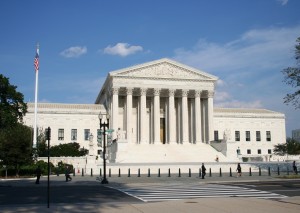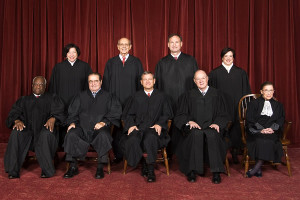Finding Nino’s Replacement: Lessons from POTUS/SCOTUS History
 Written by: Barbara A. Perry, Miller Professor of Ethics and Institutions, Director of Presidential Studies at UVA’s Miller Center and former Supreme Court Fellow.
Written by: Barbara A. Perry, Miller Professor of Ethics and Institutions, Director of Presidential Studies at UVA’s Miller Center and former Supreme Court Fellow.
A shorter version of this blog entitled “One-third of all U.S. presidents appointed a Supreme Court justice in an election year” appeared in The Monkey Cage at the Washington Post on 2/29/2016.
Part I
Eminent Supreme Court Justice Oliver Wendell Holmes famously described his fractious fellow judges as “nine scorpions in a bottle.” Today’s black-robed jurists are harmless butterflies, however, in contrast to the swarm of contenders for the GOP presidential nomination. Justice Antonin Scalia’s passing had hardly been revealed when the Republican candidates stung early and often in proclaiming that President Obama should not appoint the late justice’s successor. The buzz continued on Capitol Hill, with Senate Republicans asserting that the American people should have a voice in choosing the next Supreme Court nominee, via November’s ballot box. President Obama countered that he would perform his constitutional duty and nominate a Scalia successor, adding, “Your job doesn’t stop until you are voted out or until your term expires.” The historical record supports that position: 14 presidents have appointed 21 justices during presidential election years. A half-dozen presidents, classic lame ducks, filled Supreme Court seats even though their successors had already been elected.
President Benjamin Harrison had been defeated in his 1892 re-election bid by former President Grover Cleveland, for example, when Associate Justice Lucius Quintus Cincinnatus Lamar died in office in January 1893. At that time, and until 1937, presidents were inaugurated in March, not January. To avoid four months of hobbled presidents, the 20th Amendment to the Constitution shortened the period between election and taking office. While running for re-election, Harrison had already appointed his third justice the previous July, and he was not dissuaded from a fourth nomination to the high court, despite his dwindling White House tenure. Republican Harrison bowed to partisan realities, however, by nominating his Democrat friend, Howell Jackson. The Senate was soon to change hands from Republican to Democratic control, and Harrison’s bi-partisan gambit worked: Jackson received unanimous approval one month before Cleveland’s inauguration.
This is why Judge Sri Srinivasan of the DC Circuit is receiving so much attention as a potential nominee to the nation’s highest tribunal. His judicial clerkships for Republican nominees and moderate conservatives, 4th Circuit Court Judge J. Harvie Wilkinson III and Supreme Court Justice Sandra Day O’Connor, both Reagan appointees, reflect bi-partisanship. His immigrant roots in India provide a compelling American-dream story. The first Indian-American justice to replace the first Italian-American on the Supreme Court maintains a historic symmetry. Moreover, Srinivasan’s religious affiliation (Hindu) would add religious diversity to a bench populated solely by Catholic or Jewish justices for the past 6 years. Such an appointment would follow a long presidential tradition of placing religious minorities on the Supreme Court long before their co-religionists were represented in high elected offices. Of course, the primary criterion for selection should be demonstrable merit, and Srinivasan more than meets that standard with his Stanford degrees and professional experience, so much so that the Republican-controlled Senate approved him unanimously when Obama nominated him for the DC Circuit, a Supreme Court proving ground, in 2013.
Although Benjamin Harrison exemplifies the most recent lame duck to place a justice on the Supreme Court, five other presidents (Hayes, Tyler, Van Buren, Jackson, and Adams) did so. All but Jackson, who named a justice on the last full day of his two terms, had been defeated or withdrawn from the election. Adams’ last-minute appointment of his Secretary of State John Marshall to chief justice, a parting Federalist slap at the Jeffersonians, makes today’s partisan rows look tame by comparison. “That gloomy malignity,” as Thomas Jefferson inaccurately described Marshall, would preside over the Court for 34 years, long after the Federalist Party faded from the scene. The US Supreme Court labels him the “Great Chief Justice” for his masterful leadership and foundational interpretations of the Constitution.
Aside from genuine lame ducks, one third of US presidents appointed justices during presidential election years. A handful fall into the same category as President Obama: presidents not running for re-election. George Washington, who established precedents that shape the office to this day, declined to run for a third term, but he added an associate justice and a chief justice during the election year of 1796. Jackson and Cleveland followed the two-term tradition, but each appointed members of the Supreme Court in the election year before leaving office. Like Obama, Jackson faced an obstinate Senate, which had postponed a vote on his nomination of Roger Taney for an associate justice position early in 1835. Not to be deterred, Old Hickory re-nominated Taney nearly a year later, this time to chief justice, upon the death of John Marshall. Taney, the Court’s first Catholic, would assume his seat just 7 months before the 1836 presidential election.
Part II
Three presidents who appointed Supreme Court justices in an election year (Hoover, Taft, and B. Harrison) were running for re-election but ultimately lost. If Hoover had abjured his duty to replace retiring Justice Holmes in February 1932, the Court might have been denied the intellectual services of Benjamin Cardozo, by all accounts a stellar justice. Hoover faced a closely divided Senate, but Cardozo was so universally admired that his confirmation was unanimous. William Howard Taft, who would lose his 1912 re-election campaign, achieved the position he most coveted, chief justice of the United States, when appointed to the high court by Warren Harding in 1921. In an interesting twist, Taft served on the Supreme Court with the associate justice, Mahlon Pitney, whom he had appointed in his last year before leaving the White House.
Franklin Roosevelt and five other presidents (Nixon, Eisenhower, Wilson, Cleveland, and Jefferson) placed justices on the Supreme Court during the election years in which they would win another term. Ike faced an opening just three weeks before the 1956 election when Justice Sherman Minton left the bench in ill health. Looking for support from the electoral-vote rich Northeast, Eisenhower immediately selected William Brennan, a New Jersey Catholic, in a recess appointment. Catholics, a key component of the FDR’s New Deal coalition, were also represented in his 1940 election year nomination of Frank Murphy to fill the seat of deceased Catholic justice Pierce Butler. Nixon’s two appointments in 1972 of William Rehnquist and Lewis Powell were a bonanza for his campaign theme of reshaping the Court to counter the liberal Warren-era decisions. It contributed to his landslide victory over George McGovern. Nixon couldn’t have predicted that a mere two years later his reshaped bench would unanimously rule against him in the Watergate tapes case (with only Rehnquist recusing himself).
Two additional presidents (Lincoln and Grant) named Supreme Court members after they had been re-elected but before their second inauguration. When Roger Taney died in late 1864, after 32 years on the bench, Lincoln happily replaced the Jacksonian chief justice with his Republican Secretary of the Treasury Salmon Chase.
Justice Scalia’s 30-year tenure confirms President Gerald Ford’s observation that “few appointments a president makes can have as much impact on the future of the country as those to the Supreme Court.” That truism, even more apposite now when the Court is evenly split on the most contentious political issues of the day, explains why the Founding Fathers spent so much time debating the process of selecting justices.
Nearly silent on judicial qualifications, the founders gave considerable thought at Philadelphia’s 1787 constitutional convention to the best method of choosing them. The delegates initially considered appointment of federal judges by the national legislature. Pennsylvania’s James Wilson, a future member of the Court, opposed the proposal, arguing that “[i]ntrigue, partiality, and concealment” resulted from judicial appointments by legislatures. Future president James Madison, often called the “Father of the Constitution,” added that members of the legislature “were not judges of the requisite qualifications” for jurists. Wilson thought that the newly created office of the president should have sole authority to choose judges, but John Rutledge of South Carolina thought that plan too monarchical.
As so frequently happened at the convention, perhaps because it operated in secret, the delegates reached a compromise, eventually settling on nomination to the Supreme Court by the president, with appointment contingent on the Senate’s prerogative to advise and consent. While the exact nature of that prerogative has been endlessly debated, the original intent of the Constitution’s framers, which the late Justice Scalia squarely embraced, was to produce qualified Supreme Court justices by checking and balancing the “ambitions” inherent in the chief executive and Congress’s upper house. It was not to allow the voter (even the white, male, landed-gentry electorate of that era) a direct role in the process. In fact, the founders did not create a popularly elected Senate, hoping that it would reflect statesmanship that is often a step removed from what Madison called the “opinions” and “passions” of the people.
- Musings on National Violin Day
- Making the Promise Real: How a UN Tax Convention Can Fulfill the UNDHR’s Vision
- Having a Drink With Your Donkey: The Absurd in Antiquity
- UVA Club of Atlanta: Virtual Pilates Class
- UVA Club of Fairfield/Westchester: Cavs Care - Food Pantry Donation Drive
- UVA Club of Washington DC: Tour of the U.S. Capitol


